Magnetic Sublevel Independent Magic and Tune-out Wavelengths of the Alkaline-earth Ions
Abstract
Lightshift of a state due to the applied laser in an atomic system vanishes at the tune-out wavelengths (s). Similarly, differential light shift of a transition vanishes at the magic wavelengths (s). In many of the earlier studies, values of the electric dipole (E1) matrix elements were inferred precisely by combining measurements of with the calculated their values. Similarly, the values of an atomic state can be used to infer the E1 matrix element as it involves dynamic electric dipole () values of only one state whereas the values are dealt with values of two states. However, both the and values depend on angular momenta and their magnetic components () of states. Here, we report the and values of many and states, and transitions among these states of the Mg+, Ca+, Sr+ and Ba+ ions that are independent of - values. Measuring these wavelengths in a special set-up as discussed in the paper, it could be possible to infer a large number of E1 matrix elements of the above ions accurately.
I Introduction
Singly charged alkaline-earth ions are the most eligible candidates for considering for the high-precision measurements due to several advantages zhuang2014active . Except Be+ and Mg+, other alkaline-earth ions have two metastable states and most of the transitions among the ground and metastable states are accessible by lasers. This is why these ions are considered for carrying out high-precision measurements such as testing Lorentz symmetry violations kostelecky2018lorentz ; Wood19971759 ; tiecke2014nanophotonic , parity nonconservation effects xiaxing1990parity , non-linear isotope shift effects PhysRevA.68.022502 , quantum information PhysRevLett.98.070801 ; roos2004control and many more including for the optical atomic clock experiments PhysRevA.72.043404 . One of the major systematics in these measurements is the Stark shift due to the employed laser, which depends on the frequency of the laser. The solution to this problem was suggested by Katori et al. katori1999optimal who proposed that the trapping laser can be tuned to wavelengths at which differential ac Stark shifts of the transitions can vanish katori1999optimal . These wavelengths were coined as magic wavelengths ()s and being popularly used in the optical lattice clocks. There are also applications of the magic wavelengths for carrying measurements of atoms trapped inside high-Q cavities in the strong-coupling regime Mckeever . In quantum state engineering Sackett , magic wavelengths provide an opportunity to extract accurate values of oscillator strengths Tang that are particularly important for the correct stellar modeling and analysis of spectral lines identified in the spectra of stars and other heavenly bodies so as to infer fundamental stellar parameters ruffoni2014fe ; wittkowski2005fundamental .
Apart from the magic trapping condition, where light shift of two internal states is identical, another well known limiting case is where light shift of one state vanishes. This case is known as tune-out condition PhysRevLett.125.023201 . Applications of such tune-out wavelengths () lie in novel cooling techniques of atoms PhysRevLett.103.140401 , selective addressing and manipulation of quantum states PhysRevLett.115.043003 ; PhysRevA.73.041405 ; PhysRevX.9.041014 , precision measurement of atomic structures PhysRevLett.109.243004 ; PhysRevLett.109.243003 ; doi:10.1080/00268976.2013.777812 ; PhysRevLett.115.043004 ; Kao:17 ; PhysRevLett.124.203201 and precise estimation of oscillator strength ratios arora2011tune . Additionally, tune-out conditions are powerful tools for the evaporative cooling of optical lattices PhysRevLett.125.023201 and hence, are important for experimental explorations.
In one of the experiments pertaining to magic wavelengths of alkaline-earth ions, Liu et al. demonstrated the existence of magic wavelengths for a single trapped 40Ca+ ion Liu whereas Jiang et al. evaluated magic wavelengths of Ca+ ions for linearly and circularly polarized light using relativistic configuration interaction plus core polarization (RCICP) approach jiang2017magic ; jiang2017 . Recently, Chanu et al. proposed a model to trap Ba+ ion by inducing an ac Stark shift using nm linearly polarized laser Chanu_2020 . Kaur et al. reported magic wavelengths for and transitions in alkaline-earth-metal ions using linearly polarized light Jasmeet whereas Jiang et al. located magic and tune-out wavelengths for Ba+ ion using RCICP approach PhysRevA.103.032803 . Despite having a large number of applications, these magic wavelengths suffer a setback because of their dependency on the magnetic-sublevels () of the atomic systems. Linearly polarized light has been widely used for the trapping of atoms and ions as it is free from the contribution of the vector component in the interaction between atomic states and electric fields. However, the magic wavelengths thus identified are again magnetic-sublevel dependent for the transitions involving states with angular momenta greater than . On the other hand, the implementation of circularly polarized light for trapping purposes requires magnetic-sublevel selective trapping. In order to circumvent this -dependency of magic wavelengths, a magnetic-sublevel independent strategy for trapping of atoms and ions was proposed by Sukhjit et al. Sukhjit . Later on, Kaur et al. implemented similar technique to compute magic and tune-out wavelengths independent of magnetic sublevels for different – transitions in Ca+, Sr+ and Ba+ ions corresponding to n= for Ca+, for Sr+ and for Ba+ ion kaur2017annexing .
In addition to the applications of in getting rid of differential Stark shift in a transition, they are also being used to infer the electric dipole (E1) matrix elements of many allowed transitions in different atomic systems [J. A. Sherman, T. W. Koerber, A. Markhotok, W. Nagourney, and E. N. Fortson Phys. Rev. Lett. 94, 243001 (2005); B. K. Sahoo, L. W. Wansbeek, K. Jungmann, and R. G. E. Timmermans, Phys. Rev. A 79, 052512 (2009); Liu et al, Phys Rev. Lett. 114, 223001 (2015); Jun Jiang, Yun Ma, Xia Wang, Chen-Zhong Dong, and Z. W. Wu, Phys. Rev. A 103, 032803 (2021) etc.]. The basic procedure of these studies is that the values are calculated by fine-tuning the magnitudes dominantly contributing E1 matrix elements to reproduce their measured values. Then, the set of the E1 matrix elements that give rise the best matched values are considered as the recommended E1 matrix elements. However, calculations of these values of a transition demand determination of dynamic E1 polarizabilities () of both the states. In view of this, use of values of a given atomic state can be advantageous as they involve dynamic values of only one state. Furthermore, both the and values depend on angular momenta and their magnetic components () of atomic states. This requires evaluation of scalar, vector and tensor components of the values for states with angular momenta greater than , which is very cumbersome. To circumvent this problem, we present here -sublevel independent and values of many states and transitions involving a number of and states in the alkaline-earth metal ions from Mg+ through Ba+ that can be inferred to the E1 matrix elements more precisely. We have used the E1 matrix elements from an all-order relativistic atomic many-body method to report the -Independent and values to search for these values in the experiments, when they are measured precisely the E1 matrix elements need to be fine-tuned in order to minimize their uncertainties. It can be achieved by specially setting up the experiment suitably fixing the polarization and quantization angles of the applied lasers. To validate our results for the transitions involving high-lying states, we have compared the values of our and values for the ground to the metastable states of the considered alkaline-earth ions with the previously reported values.
The paper is organized as follows: In Sec. II, we provide underlying theory and Sec. III describes the method of evaluation of the calculated quantities. Sec. IV discusses the obtained results, while concluding the study in Sec. V. Unless we have stated explicitly, physical quantities are given in atomic units (a.u.).
II Theory
The electric field (, associated with a general plane electromagnetic wave can be represented in terms of complex polarization vector and the real wave vector k by the following expression beloy2009theory
| (1) |
where is the complex-conjugate of the preceding term. Assuming to be real and adopting the coordinate system as presented in Fig. 1, the polarization vector can be expressed as Sukhjit
| (2) |
where and denote the real components of the polarization vector , is the real quantity denoting the arbitrary phase and is analogous to degree of polarization such that . For linearly polarized light, whereas takes the value either or for circularly polarized light, which further defines for linearly polarized and for right-hand (left-hand) circularly polarized light beloy2009theory . As shown in the Fig. 1, this coordinate system follows
| (3) |
and
| (4) |
Here, is the angle between quantization axis and direction of polarization vector and the parameters and are the angles between respective unit vectors and .
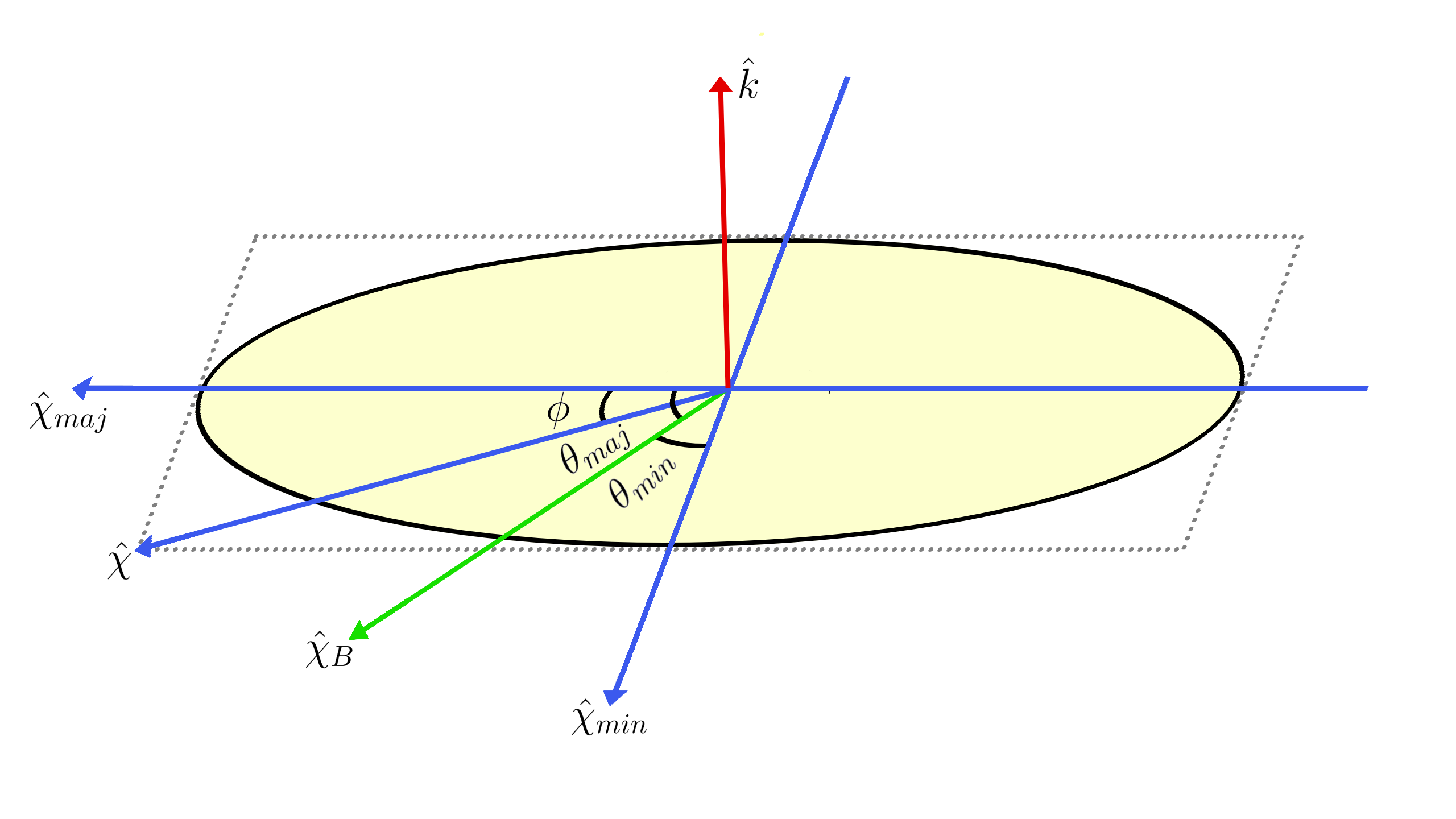
When an atomic system is subjected to the above electric field and the magnitude of is small, shift in the energy of its level (Stark shift) can be given by
| (5) |
where is known as the second-order electric dipole (E1) polarizability and the superscript denotes angular momentum of the state, which can be atomic angular momentum or hyperfine level angular momentum . Depending upon polarization, dynamic dipole polarizability can be expressed as
| (6) |
where , and are the scalar, vector and tensor components of the polarizability, respectively. In the expression can be defined on the basis of the coordinate system provided in the Fig. 1. Geometrically, values for and in their elliptical form are given as beloy2009theory ; Sukhjit
| (7) |
and
| (8) |
where is the angle between direction of propagation k and . Substitution of and from Eq. 7 and 8 reforms the expression for dipole polarizability to
| (9) |
with the azimuthal quantum number of the respective angular momentum .
Thus, it is obvious from Eq. (5) that values of two states have to be same if we intend to find for the transition involving both the states. Since the above expression for has dependency, the become dependent. In order to remove dependency, one can choose sublevels but in the atomic states of the alkaline-earth ions they are non-zero while isotopes with integer nuclear spin of the alkaline-earth ions s are again non-zero. To address this, a suitable combination of the and parameters need to be chosen such that and , which are feasible to achieve in an experiment by setting and values as demonstrated in Ref. Sukhjit . In such a scenario, the values can depend on the scalar part only by suppressing the vector and tensor components of ; i.e. the net differential Stark effect of a transition occurring from between the to states will be given by
| (10) |
This has an additional advantage that the differential Stark effects at an arbitrary electric field become independent of choice of atomic or hyperfine levels in a given atomic system as the scalar component of and are the same. Again, the same choice of values will be applicable to both the atomic and hyperfine levels in an high-precision experiment.
III Method of Evaluation
Determination of values require accurate calculations E1 matrix elements. For the computation of E1 matrix elements, we need accurate atomic wave functions of the alkaline-earth ions. We have employed here a relativistic all-order method to the determine atomic wave functions of the considered atomic systems, whose atomic states have closed core configuration with an unpaired electron in the valence orbital. Detailed descriptions of our all-order method can be found in Refs. blundell1991relativistic ; safronova2008all ; sahoo2015correlation ; sahoo2015theoretical , however a brief outline of the same is also provided here for the completeness.
Our all-order method follows the relativistic coupled-cluster (RCC) theory ansätz
| (11) |
where represents the mean-field wave function of the state and constructed as safronova1999relativistic
| (12) |
where represents the Dirac-Hartree-Fock (DHF) wave function of the closed-core. Subscript represents the valence orbital of the considered state. In our calculations, we consider only linear terms in the singles and doubles approximation of the RCC theory (SD method) by expressing safronova1999relativistic
| (13) |
where and depict terms corresponding to the single and double excitations, respectively, that can further be written in terms of second quantization creation and annihilation operators as follows iskrenova2007high
| (14) |
and
| (15) |
where indices and range over all possible virtual orbitals, and indices and range over all occupied core orbitals. The coefficients and represent excitation coefficients of the respective single excitations for the core and the valence electrons, respectively, whereas and depict double excitation coefficients for the core and the valence electrons respectively. These amplitudes are calculated in an iterative procedure safronova2007excitation due to which they include electron correlation effects to all-order.
Hence, atomic wave function of the considered states in the alkaline-earth ions are expressed as safronova1999relativistic ; kaur2020radiative :
| (16) | |||||
To improve the calculations further and understand the importance of contributions from the triple excitations in the RCC theory, we take into account important core and valence triple excitations through the perturbative approach over the SD method (SDpT method) by redefining the wave function expression as safronova1999relativistic
| (17) | |||||
After obtaining the wave functions of the interested atomic states, we evaluate the E1 matrix elements between states and as iskrenova2007high
| (18) |
where is the E1 operator with being the position of electron kaur2020radiative . The resulting expression of numerator of Eq. 18 includes the sum of the DHF matrix elements , twenty correlation terms of the SD method that are linear or quadratic functions of excitation coefficients , , and , and their core counterparts safronova2008all .
In the sum-over-states approach, expression for the scalar dipole polarizability is given by
| (19) |
where is the reduced matrix element for the transition occurring between the states involving the valence orbitals and . Here, we have dropped the superscript in the dipole polarizability notation for the brevity. For the convenience, we divide the entire contribution to in three parts as
| (20) |
where and corresponds to core, valence-core and valence contributions arising due to the correlations among the core orbitals, core-valence orbitals and valence-virtual orbitals respectively Arora . Due to very smaller magnitudes, the core and core-valence contributions are calculated by using the DHF method. The dominant contributions will arise valence from due to small energy denominators. Again, the high-lying states will not contribute to owing to large energy denominators. Thus, we calculate E1 matrix elements only among the low-lying excited states and refer the contributions as ‘Main’. Contributions from the less contributing high-lying states are referred as ‘Tail’ and are estimated again using the DHF method. To reduce the uncertainties in the estimations of Main contributions, we have used experimental energies of the states from the National Institute of Science and Technology atomic database (NIST AD) ralchenko2005nist .
IV Results and Discussion
The precise computation of magic and tune-out wavelengths requires the accurate determination of E1 matrix elements as well as dipole polarizabilities. In our work, we have used E1 matrix elements and energies for different states available on Portal for High-Precision Atomic Data and Computation UDportal and NIST Atomic Spectra Database ralchenko2005nist , respectively.
We have listed resonance transitions, magic wavelengths and their corresponding polarizabilities for magnetic-sublevel independent – transitions for alkaline-earth ions from Mg+ through Ba+ along with their comparison with available literature in the Tables 1 through 4, respectively. The further discussion regarding the magic wavelengths is provided in the subsection IV.1 for the considered alkaline-earth ions. Furthermore, we have discussed our results for tune-out wavelengths in the subsection IV.2 along with the comparison of our results with respect to the available theoretical data.
IV.1 Magic Wavelengths
IV.1.1 Mg+
| Resonance | Resonance | ||||||||
In Table 1, we have tabulated our results for magic wavelengths and their corresponding dipole polarizabilities for – and – transitions. Fig. 2(a) demonstrates scalar dipole polarizabilities of and states of Mg+ ion with respect to wavelength of the external field. It can be perceived from the figure that a number of magic wavelengths at the crossings of the scalar polarizabilities’ curves of the corresponding state have been predicted for the transition. As can be seen from the Table 1, a total of magic wavelengths have been found for – transition, whereas – transition shows a total of magic wavelengths in the range nm, out of which no magic wavelength is found to exist in visible spectrum. However, all the magic wavelengths enlisted in Table 1 support red-detuned trap.
Fig. 2(b) represents the plot of scalar dipole polarizabilities of and states against wavelength of the external field. It can also be assessed from Table 1 that there exists a total of nine magic wavelengths in the considered wavelength range for – transition, whereas only five magic wavelengths are spotted for – transition. However, in both the cases, all the magic wavelengths except those around nm, nm and nm are close to resonance, thereby making them unsuitable for further use. However, out of these three values, at nm lies in the visible region and is far-detuned with considerable deep potential. Hence, we recommend this magic wavelength for trapping of Mg+ ion for both – transitions for further experimentations in optical clock applications.
Fig. 2(c) demonstrates the magic wavelengths for MJ independent scheme for – transitions for Mg+ ion along with their corresponding scalar dynamic polarizabilities. According to Table 1, it can be realized that none of the magic wavelengths for these transitions lies within the visible spectrum of electromagnetic radiations. However, all of these magic wavelengths support red-detuned trap, except nm and nm for - and – transitions, respectively, support far blue-detuned traps and are found to be useful for experimental demonstrations.
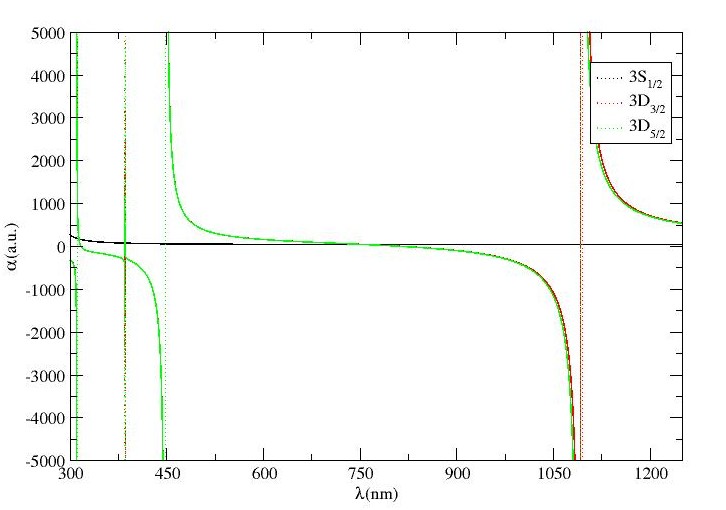
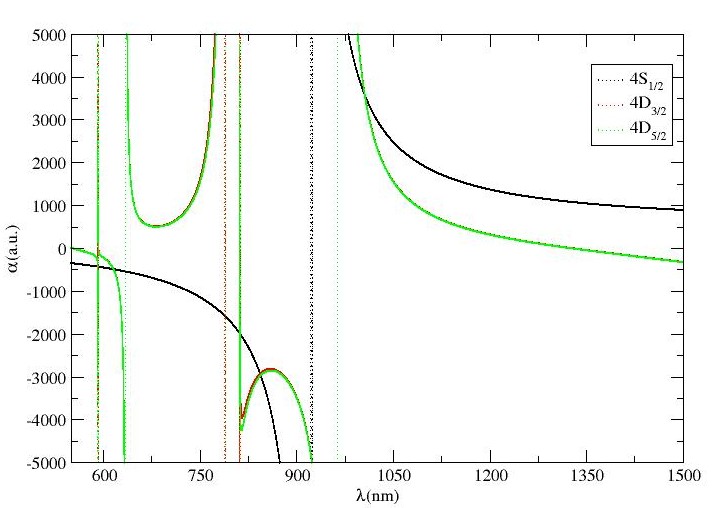
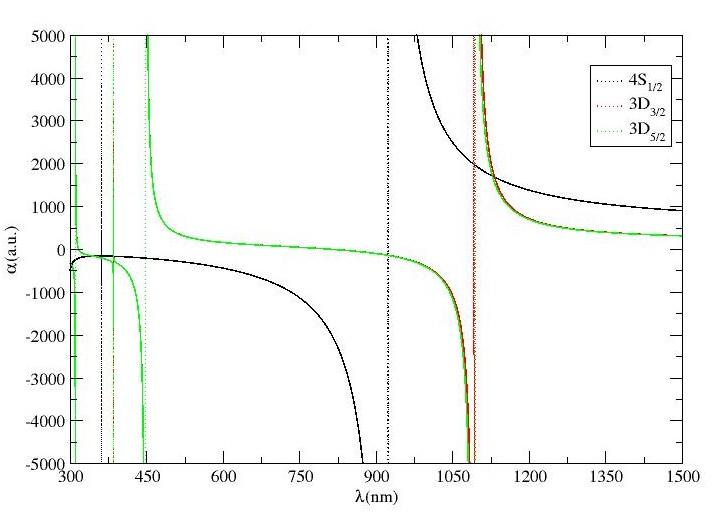
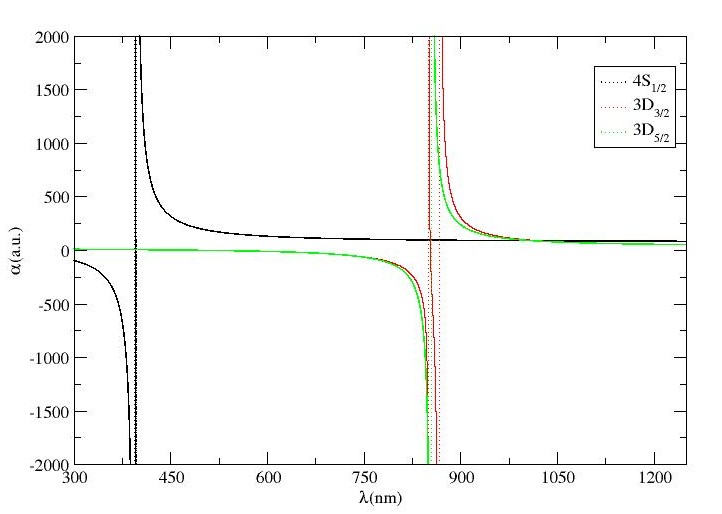
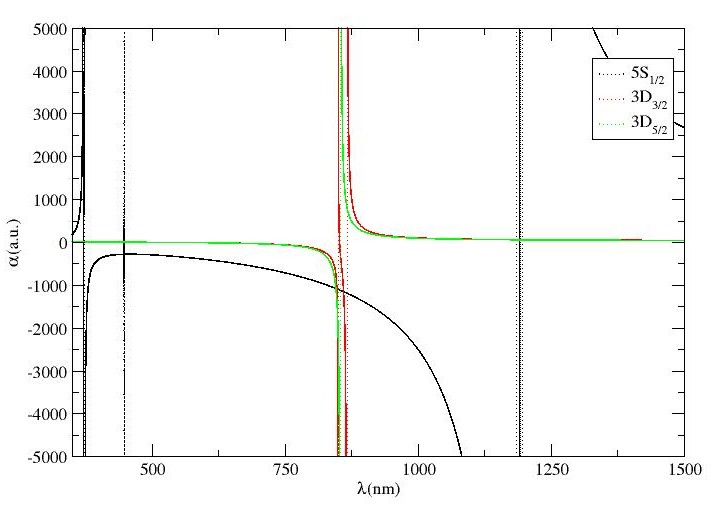
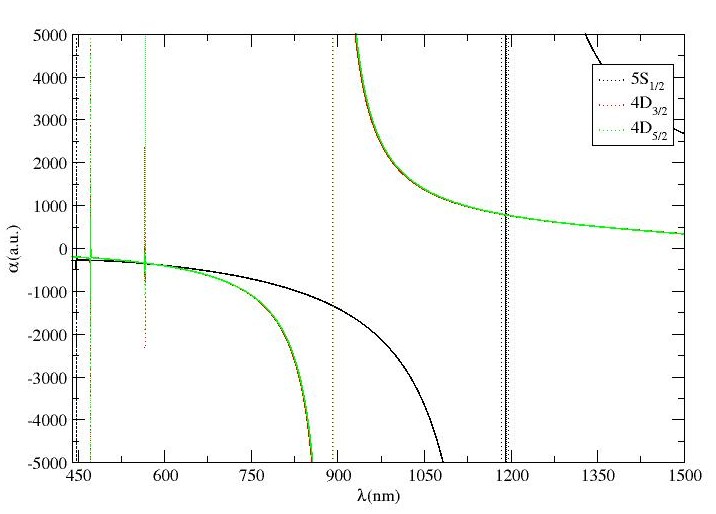
IV.1.2 Ca+
| Resonance | Resonance | ||||||||
| kaur2017annexing | kaur2017annexing | kaur2017annexing | kaur2017annexing | ||||||
| kaur2017annexing | kaur2017annexing | kaur2017annexing | kaur2017annexing | ||||||
| kaur2017annexing | kaur2017annexing | ||||||||
We have considered – and – transitions for locating the magic wavelengths in Ca+ ion. We have tabulated magic wavelengths for these transitions along with the comparison of s with the only available results for – in Table 2. Also, we have plotted scalar dipole polarizabilities against wavelengths for these transitions in Figs. 2(d), 2(e) and 2(f) correspondingly. According to Table 2, it is ascertain that subsequently three and two magic wavelengths exist between nm and nm for – transitions. In both cases, except nm and nm magic wavelengths, that are far-detuned, all other magic wavelengths are close to resonances and are not suitable for laser trapping.
During analysis, six and five magic wavelengths are located for – and – transitions, respectively. It is also analyzed that all the magic wavelengths are approximately same for both – and – transitions. Moreover, s around nm, nm and nm share deep trapping potential for blue-detuned traps and hence, are further recommended for configuring feasible traps. at nm, identified in infrared region for both - transitions, is the only magic wavelength that supports red-detuned trap. Besides, the polarizability for this wavelength is sufficient enough for creating an ion trap at reasonable laser power. To validate our results, we have also compared our results with the results provided only for – in Ref. kaur2017annexing , and noticed that the results for these transitions are in good agreement with only less than variation w.r.t. obtained results.
IV.1.3 Sr+
| Resonance | Resonance | ||||||||
| kaur2017annexing | kaur2017annexing | kaur2017annexing | kaur2017annexing | ||||||
| kaur2017annexing | kaur2017annexing | ||||||||
Fig.s 3(a), 3(b) and 3(c) demonstrate the MJ-independent dynamic dipole polarizability versus wavelength plots for – and – transitions for Sr+ ion. The results corresponding to these figures have been enlisted in Table 3. Only two magic wavelengths have been traced for – transition, whereas only one magic wavelength exists for – transition. According to Table 3, for – transition, three magic wavelengths exist below nm, with a dynamic polarizability of value less than a.u., however, other three s, lie between nm and nm. The s at nm and nm support blue-detuned traps with sufficiently high polarizabilities for experimental trapping of Sr+ ion. For – transition, five magic wavelengths have been located between nm and nm, out of which, the magic wavelengths at nm, nm, nm and nm follow red-detuned traps whereas the only magic wavelength at nm with corresponding a.u., supports blue-detuned trap which can be useful for experimental purposes. We recommend this magic wavelength of Sr+ ion for - transition. Moreover, it is also observed that all the magic wavelengths for these two transitions lie between same resonance transitions and are closer to each other. So, it is probable to trap Sr+ ion for both of these transitions with same magic wavelength. Table 3 also shows that there are four magic wavelengths which lie within the wavelength range of nm to nm for – transition. It is also observed that three out of four magic wavelengths for – transition support blue-detuned traps, however the nm at a.u. is recommended for experimental purposes as it is far-detuned and a high value of dipole polarizability indicates deep trapping potential. On the other hand, only three magic wavelengths have been identified for – transition in Sr+ ion with two supporting blue-detuned traps. Two out of these s, i.e., nm and nm are located at higher wavelength range, with deep potentials for their respective favourable blue- and red-detuned traps. Therefore, both of these values are recommended for further experimental studies. Moreover, we have compared our magic wavelengths for – transitions with respect to available literature in the same table. It is seen that our reported values are in excellent approximation with the results obtained by Kaur et al. kaur2017annexing with a variation less than . Unfortunately, we couldn’t find any data related to other transitions to carry out the comparison with. Hence, it can be concluded from the comparison of available data that our results are promising and can be used for further prospective calculations of atomic structures and atomic properties of this ion.
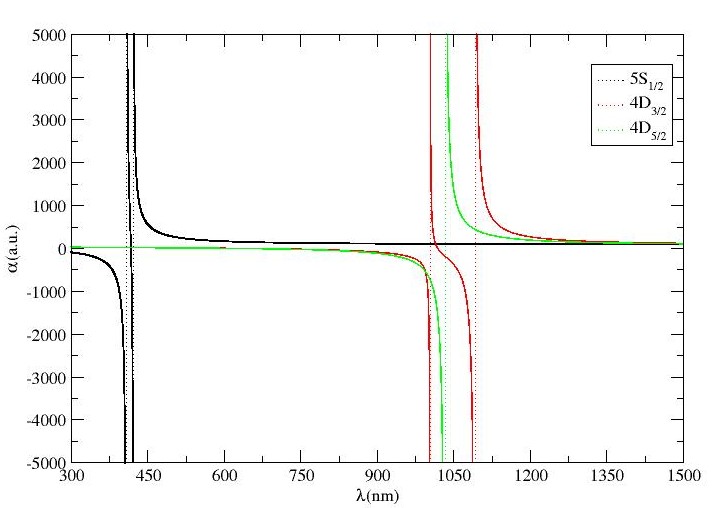
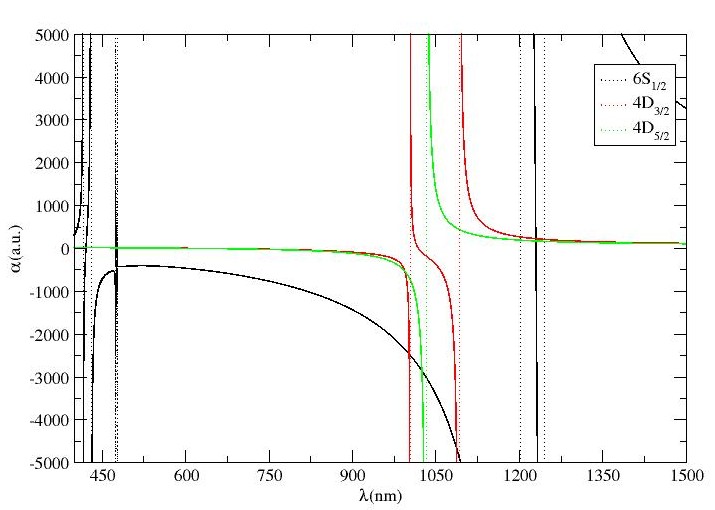
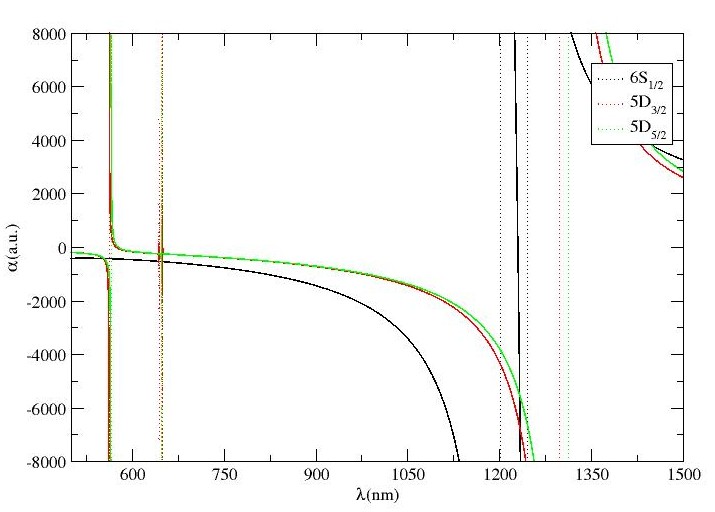
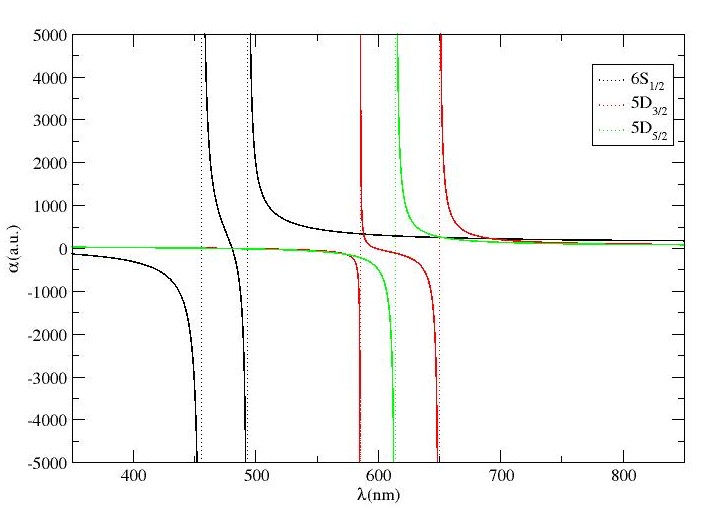
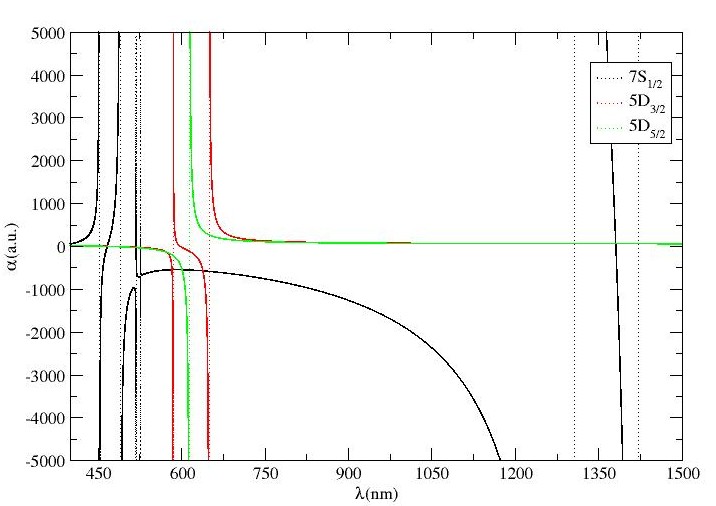
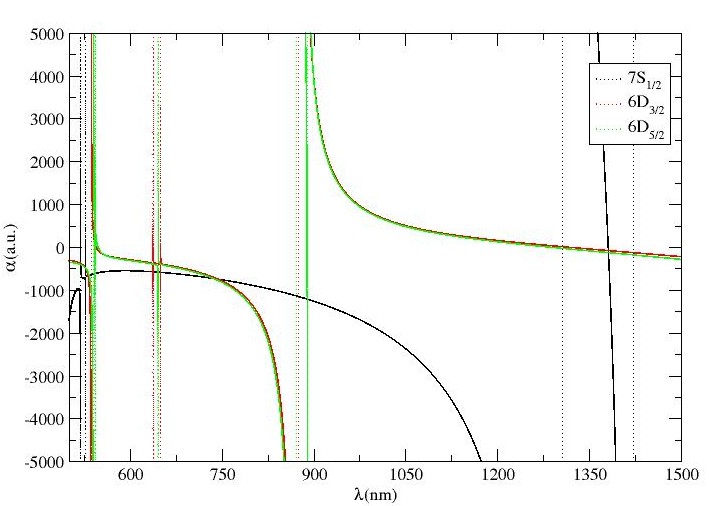
IV.1.4 Ba+
| Resonance | Resonance | ||||||||
| kaur2017annexing | kaur2017annexing | ||||||||
| kaur2017annexing | kaur2017annexing | kaur2017annexing | kaur2017annexing | ||||||
| kaur2017annexing | kaur2017annexing | ||||||||
The results for magic wavelengths for –, – and – transitions in Ba+ ion are tabulated in tables 4. As per Fig. 3(d) and Table4, A maximum of magic wavelengths have been located between and nm. It is also observed that the magic wavelengths that lie between – and – resonant transitions support blue-detuned trap, however, the dynamic dipole polarizability corresponding to these magic wavelengths are too small to trap Ba+ ion at these wavelengths. A total of six magic wavelengths are found for – transition out of which two lie in the vicinity of nm. The sharp intersection of polarizability curves of the involved states of transition lie at nm, nm and nm. Similarly, four magic wavelengths have been identified for – transition, however, unlike - transition, no magic wavelength has been identified in the vicinity of to nm. It is also analyzed that three out of these four s, support blue-detuned trap, although the trapping potentials for these traps are not deep enough for further consideration to experimentations.
Table4 also compiles the magic wavelengths for – transitions and shows that there exists six and four magic wavelengths for – and – transition, respectively. It is also seen that the magic wavelengths between – and – as well as – and – transitions seem to be missing as shown in Fig. 3(e). It is also observed that the magic wavelength at nm and nm are slightly red-shifted, nevertheless, the at nm lies in visible region supports blue-detuned trap, can have sufficient trap depth at reasonable laser power.
Similarly, the magic wavelengths and their corresponding dynamic dipole polarizability along with their comparison with available literature is also provided in the same table for – transitions. The same have been demonstrated graphically in the Fig. 3(f) which includes a total of thirteen magic wavelengths in all for the considered transitions. It is also examined that no magic wavelength exists between – and – resonances. Unlike – transition, around eight magic wavelengths have been located between – and – resonances, and all of them support blue-detuned traps. Moreover, magic wavelengths at nm, nm and nm are expected to be more promising for experiments due to sufficient trap depths for the reasonable power lasers. However, on the comparison of our results for – transitions for Ba+ ion, we have observed that all the magic wavelengths agree well with the results obtained by Kaur et al. in Ref. kaur2017annexing , except the last magic wavelengths that are identified at nm and nm for – and – transitions.
IV.2 Tune-out Wavelengths
| Mg+ | Ca+ | Sr+ | Ba+ | ||||||||
|---|---|---|---|---|---|---|---|---|---|---|---|
| State | Others | State | Others | State | Others | State | Others | ||||
| kaur2021tune | |||||||||||
| kaur2017annexing | |||||||||||
| kaur2021tune | |||||||||||
| kaur2017annexing | |||||||||||
| kaur2021tune | kaur2021tune | ||||||||||
| jiang2021tune | |||||||||||
| kaur2017annexing | |||||||||||
| kaur2017annexing | |||||||||||
| kaur2017annexing | kaur2017annexing | ||||||||||
| kaur2017annexing | kaur2017annexing | ||||||||||
| kaur2017annexing | |||||||||||
| kaur2017annexing | kaur2017annexing | ||||||||||
| kaur2017annexing | |||||||||||
We have illustrated tune-out wavelengths for different states of the considered transitions in the alkaline-earth ions along with their comparison with already available literature in Table 5. To locate these MJ-independent tune-out wavelengths, we have evaluated scalar dipole dynamic polarizabilities of these states for considered alkaline-earth ions and identified those values of for which polarizability vanished. It is also accentuated that in Mg+ ion, all the tune-out wavelengths identified for and states lie in UV region, whereas for states, a few tune-out wavelengths are located in visible range. Moreover, the largest is identified for state at nm. Furthermore, only one tune-out wavelength,i.e., nm for could be compared with the result presented by Kaur et al. in Ref. kaur2021tune and it is seen that our result is in good accord with this value. Similarly, we have pointed out tune-out wavelengths for and , and states for Ca+, Sr+ and Ba+ ions, by identifying s at which their corresponding s tend to zero. Hence, it has been perceived that out of tune-out wavelengths for all states of Ca+ ion, only seven of them lie within visible spectrum and on comparison of different tune-out wavelengths for and states of Ca+ ion, it has been analyzed that all of these results are advocated by the results obtained in Refs. kaur2017annexing ; kaur2021tune . However, one of the tune-out wavelength has been located at nm for state of Ca+ ion seems have variation from the wavelength obtained by Kaur et al. in Ref. kaur2017annexing . This may be due to the fact that our study incorporates all the highly precise E1 matrix elements as well energies of the states available at Portal for High-Precision Atomic Data and Computation UDportal , which appears to be missing in previous studies. For Sr+ ion, maximum number of tune-out wavelengths have been identified out of all the considered alkaline-earth ions. It is also realized that most of these s lie within visible spectrum of electromagnetic radiation, are mostly comprise of all the values corresponding to , and states. Additionally, during the comparison of these values with the results published in Refs. kaur2017annexing ; kaur2021tune , it is examined that tune-out wavelength at nm for as well as nm for state agree well with the available results, howsoever, the tune-out wavelengths at nm and nm for and states, respectively show a discrepancy of less than which lies within quoted error limit. In case of Ba+ ion, we have located tune-out wavelengths, which in all comprise of , and wavelengths in visible, UV and infrared regions, respectively. It is also accentuated that all the tune-out wavelengths that exist in visible region lie within the range nm to nm. We have also compared our tune-out wavelengths for and states against available theoretical data in Refs. kaur2017annexing ; kaur2021tune ; jiang2021tune and it is found that all the s except nm and nm, respectively for and states show disparity less than which lies within the considerable error limit.
V Conclusion
We have identified a number of reliable magnetic-sublevel independent tune-out wavelengths of many and states, and magic wavelengths of different combinations of – transitions in the alkaline-earth ions from Mg+ through Ba+. If they can be measured precisely, accurate values of many electric dipole matrix elements can be inferred by combining the experimental values of these quantities with our theoretical results. Most of the magic wavelengths found from this study show that they can be detected using the red and blue-detuned traps. In fact, it is possible to perform many high-precision measurements by trapping the atoms at the reported tune-out and magic wavelengths of the considered transitions in the future that can be applied to different metrological studies.
References
- [1] Wei Zhuang, Tong-Gang Zhang, and Jing-Biao Chen. An active ion optical clock. Chinese Physics Letters, 31(9):093201, 2014.
- [2] V Alan Kosteleckỳ and Arnaldo J Vargas. Lorentz and c p t tests with clock-comparison experiments. Physical Review D, 98(3):036003, 2018.
- [3] C.S. Wood, S.C. Bennett, D. Cho, B.P. Masterson, J.L. Roberts, C.E. Tanner, and C.E. Wieman. Measurement of parity nonconservation and an anapole moment in cesium. Science, 275(5307):1759 – 1763, 1997. Cited by: 938.
- [4] TG Tiecke, Jeffrey Douglas Thompson, Nathalie Pulmones de Leon, LR Liu, Vladan Vuletić, and Mikhail D Lukin. Nanophotonic quantum phase switch with a single atom. Nature, 508(7495):241–244, 2014.
- [5] Xiong Xiaxing, He Mouqi, Zhao Youyuan, and Zhang Zhiming. The parity non-conservation e1 matrix of barium-a semi-empirical calculation. Journal of Physics B: Atomic, Molecular and Optical Physics, 23(23):4239, 1990.
- [6] J. C. Berengut, V. A. Dzuba, and V. V. Flambaum. Isotope-shift calculations for atoms with one valence electron. Phys. Rev. A, 68:022502, Aug 2003.
- [7] T. M. Fortier, N. Ashby, J. C. Bergquist, M. J. Delaney, S. A. Diddams, T. P. Heavner, L. Hollberg, W. M. Itano, S. R. Jefferts, K. Kim, F. Levi, L. Lorini, W. H. Oskay, T. E. Parker, J. Shirley, and J. E. Stalnaker. Precision atomic spectroscopy for improved limits on variation of the fine structure constant and local position invariance. Phys. Rev. Lett., 98:070801, Feb 2007.
- [8] Christian F Roos, Mark Riebe, Hartmut Haffner, Wolfgang Hansel, Jan Benhelm, Gavin PT Lancaster, Christoph Becher, Ferdinand Schmidt-Kaler, and Rainer Blatt. Control and measurement of three-qubit entangled states. science, 304(5676):1478–1480, 2004.
- [9] Masatoshi Kajita, Ying Li, Kensuke Matsubara, Kazuhiro Hayasaka, and Mizuhiko Hosokawa. Prospect of optical frequency standard based on a ion. Phys. Rev. A, 72:043404, Oct 2005.
- [10] Hidetoshi Katori, Tetsuya Ido, and Makoto Kuwata-Gonokami. Optimal design of dipole potentials for efficient loading of sr atoms. Journal of the Physical Society of Japan, 68(8):2479–2482, 1999.
- [11] Josephmckeever Mckeever, J Buck, AD Boozer, A Kuzmich, Hanns-Christoph Nägerl, D Stamper-Kurn, and H Kimble. State-insensitive cooling and trapping of single atoms in an optical cavity. Physical review letters, 90(14):133602, 04 2003.
- [12] Charles Sackett, David Kielpinski, B. King, Chris Langer, V. Meyer, Chris Myatt, M. Rowe, Q. Turchette, Wayne Itano, D. Wineland, and C. Monroe. Experimental entanglement of four particles. Nature, 404(15), 04 2000.
- [13] Yong-Bo Tang, Hao-Xue Qiao, Ting-yun Shi, and J. Mitroy. Dynamic polarizabilities for the low lying states of ca+. Physical Review A, 87(16), 04 2013.
- [14] MP Ruffoni, EA Den Hartog, JE Lawler, NR Brewer, K Lind, G Nave, and JC Pickering. Fe i oscillator strengths for the gaia-eso survey. Monthly Notices of the Royal Astronomical Society, 441(4):3127–3136, 2014.
- [15] M Wittkowski. Fundamental stellar parameters technology roadmap for future interferometric facilities, proceedings of the european interferometry initiative workshop organized in the context of the 2005 join european and national astronomy meeting” distant worlds”, 6-8 july 2005, liège university, institute of astrophysics, edited by j. surdej, d. caro, and a. detal. Bulletin de la Société Royale des Sciences de Liège, 74:165–181, 2005.
- [16] Roman Bause, Ming Li, Andreas Schindewolf, Xing-Yan Chen, Marcel Duda, Svetlana Kotochigova, Immanuel Bloch, and Xin-Yu Luo. Tune-out and magic wavelengths for ground-state molecules. Phys. Rev. Lett., 125:023201, Jul 2020.
- [17] J. Catani, G. Barontini, G. Lamporesi, F. Rabatti, G. Thalhammer, F. Minardi, S. Stringari, and M. Inguscio. Entropy exchange in a mixture of ultracold atoms. Phys. Rev. Lett., 103:140401, Sep 2009.
- [18] Yang Wang, Xianli Zhang, Theodore A. Corcovilos, Aishwarya Kumar, and David S. Weiss. Coherent addressing of individual neutral atoms in a 3d optical lattice. Phys. Rev. Lett., 115:043003, Jul 2015.
- [19] S. Kotochigova and E. Tiesinga. Controlling polar molecules in optical lattices. Phys. Rev. A, 73:041405, Apr 2006.
- [20] Antonio Rubio-Abadal, Jae-yoon Choi, Johannes Zeiher, Simon Hollerith, Jun Rui, Immanuel Bloch, and Christian Gross. Many-body delocalization in the presence of a quantum bath. Phys. Rev. X, 9:041014, Oct 2019.
- [21] William F. Holmgren, Raisa Trubko, Ivan Hromada, and Alexander D. Cronin. Measurement of a wavelength of light for which the energy shift for an atom vanishes. Phys. Rev. Lett., 109:243004, Dec 2012.
- [22] C. D. Herold, V. D. Vaidya, X. Li, S. L. Rolston, J. V. Porto, and M. S. Safronova. Precision measurement of transition matrix elements via light shift cancellation. Phys. Rev. Lett., 109:243003, Dec 2012.
- [23] Alexander Petrov, Constantinos Makrides, and Svetlana Kotochigova. External field control of spin-dependent rotational decoherence of ultracold polar molecules. Molecular Physics, 111(12-13):1731–1737, 2013.
- [24] B. M. Henson, R. I. Khakimov, R. G. Dall, K. G. H. Baldwin, Li-Yan Tang, and A. G. Truscott. Precision measurement for metastable helium atoms of the 413 nm tune-out wavelength at which the atomic polarizability vanishes. Phys. Rev. Lett., 115:043004, Jul 2015.
- [25] Wil Kao, Yijun Tang, Nathaniel Q. Burdick, and Benjamin L. Lev. Anisotropic dependence of tune-out wavelength near dy 741-nm transition. Opt. Express, 25(4):3411–3419, Feb 2017.
- [26] A. Heinz, A. J. Park, N. Šantić, J. Trautmann, S. G. Porsev, M. S. Safronova, I. Bloch, and S. Blatt. State-dependent optical lattices for the strontium optical qubit. Phys. Rev. Lett., 124:203201, May 2020.
- [27] Bindiya Arora, MS Safronova, and Charles W Clark. Tune-out wavelengths of alkali-metal atoms and their applications. Physical Review A, 84(4):043401, 2011.
- [28] Pei-Liang Liu, Yao Huang, Wu Bian, Hu Shao, Hua Guan, Yong-Bo Tang, Cheng-Bin Li, J. Mitroy, and Ke-Lin Gao. Measurement of magic wavelengths for the clock transition. Phys. Rev. Lett., 114(21):223001, Jun 2015.
- [29] Jun Jiang, Li Jiang, Xia Wang, Deng-Hong Zhang, Lu-You Xie, and Chen-Zhong Dong. Magic wavelengths of the ca+ ion for circularly polarized light. Physical Review A, 96(4):042503, 2017.
- [30] Jun Jiang, Li Jiang, Xia Wang, Peter Shaw, Deng-Hong Zhang, Lu-You Xie, and Chen Zhong Dong. Magic wavelengths of ca+ ion for linearly and circularly polarized light. In Journal of Physics: Conference Series, volume 875, page 122003. IOP Publishing, 2017.
- [31] S. R. Chanu, V. P. W. Koh, K. J. Arnold, R. Kaewuam, T. R. Tan, Zhiqiang Zhang, M. S. Safronova, and M. D. Barrett. Magic wavelength of the clock transition. Phys. Rev. A, 101:042507, Apr 2020.
- [32] Jasmeet Kaur, Sukhjit Singh, Bindiya Arora, and Bijaya Sahoo. Magic wavelengths in the alkaline-earth-metal ions. Physical Review A, 92(34), 09 2015.
- [33] Jun Jiang, Yun Ma, Xia Wang, Chen-Zhong Dong, and Z. W. Wu. Tune-out and magic wavelengths of ions. Phys. Rev. A, 103:032803, Mar 2021.
- [34] Sukhjit Singh, Bijaya Sahoo, and Bindiya Arora. Magnetic-sublevel-independent magic wavelengths: Application to rb and cs atoms. Physical Review A, 93(35):063422, 06 2016.
- [35] Jasmeet Kaur, Sukhjit Singh, Bindiya Arora, and BK Sahoo. Annexing magic and tune-out wavelengths to the clock transitions of the alkaline-earth-metal ions. Physical Review A, 95(4):042501, 2017.
- [36] Kyle Beloy. Theory of the ac Stark effect on the atomic hyperfine structure and applications to microwave atomic clocks. University of Nevada, Reno, 2009.
- [37] SA Blundell, WR Johnson, and J Sapirstein. Relativistic all-order calculations of energies and matrix elements in cesium. Physical Review A, 43(7):3407, 1991.
- [38] MS Safronova and WR Johnson. All-order methods for relativistic atomic structure calculations. Advances in atomic, molecular, and optical physics, 55:191–233, 2008.
- [39] BK Sahoo, DK Nandy, BP Das, and Y Sakemi. Correlation trends in the hyperfine structures of fr 210, 212. Physical Review A, 91(4):042507, 2015.
- [40] BK Sahoo and BP Das. Theoretical studies of the long lifetimes of the 6 d d 3/2, 5/2 2 states in fr: Implications for parity-nonconservation measurements. Physical Review A, 92(5):052511, 2015.
- [41] MS Safronova, WR Johnson, and A Derevianko. Relativistic many-body calculations of energy levels, hyperfine constants, electric-dipole matrix elements, and static polarizabilities for alkali-metal atoms. Physical Review A, 60(6):4476, 1999.
- [42] Eugeniya Iskrenova-Tchoukova, Marianna S Safronova, and UI Safronova. High-precision study of cs polarizabilities. Journal of Computational Methods in Sciences and Engineering, 7(5-6):521–540, 2007.
- [43] UI Safronova, WR Johnson, and MS Safronova. Excitation energies, polarizabilities, multipole transition rates, and lifetimes of ions along the francium isoelectronic sequence. Physical Review A, 76(4):042504, 2007.
- [44] Mandeep Kaur, Danish Furekh Dar, BK Sahoo, and Bindiya Arora. Radiative transition properties of singly charged magnesium, calcium, strontium and barium ions. Atomic Data and Nuclear Data Tables, page 101381, 2020.
- [45] Bindiya Arora, M. Safronova, and Charles Clark. Magic wavelengths for the np-ns transitions in alkali-metal atoms. Physical Review A, 76(18), 09 2007.
- [46] Yuri Ralchenko. Nist atomic spectra database. Memorie della Societa Astronomica Italiana Supplementi, 8:96, 2005.
- [47] Parinaz Barakhshan, Adam Marrs, Akshay Bhosale, Bindiya Arora, Rudolf Eigenmann, and Marianna S. Safronova. Portal for High-Precision Atomic Data and Computation (version 2.0). University of Delaware, Newark, DE, USA. URL: https://www.udel.edu/atom [February 2022].
- [48] Mandeep Kaur, Sukhjit Singh, BK Sahoo, and Bindiya Arora. Tune-out and magic wavelengths, and electric quadrupole transition properties of the singly charged alkaline-earth metal ions. Atomic Data and Nuclear Data Tables, 140:101422, 2021.
- [49] Jun Jiang, Yun Ma, Xia Wang, Chen-Zhong Dong, and ZW Wu. Tune-out and magic wavelengths of ba+ ions. Physical Review A, 103(3):032803, 2021.